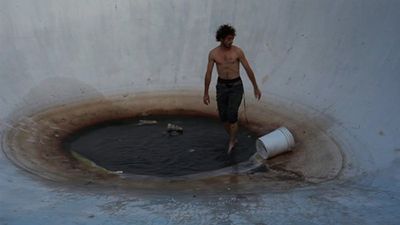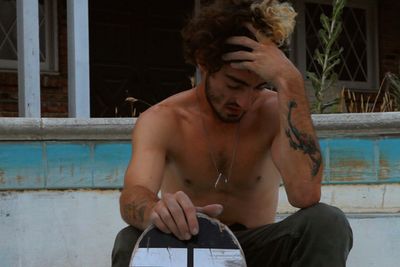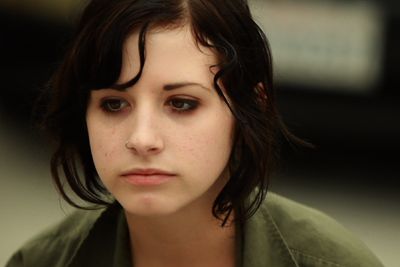Dragonslayer, Tristan Patterson's vérité doc about a very semi-pro skateboarder in Southern California, has wowed audiences and critics alike. The film took home prizes at SXSW and Hot Docs this year, and will be hitting theaters starting November 4 in New York City. Drag City and Killer Films are handling the distribution.
Dragonslayer uses new camera technology to create a jaw-dropping landscape of sound and vision. It is experimental without being tedious, rigorous without being too formal (or formal without being too rigorous). It combines the best elements of the history of cinema, documentary and photography in an original form that doesn't feel so much reverential as respectful. Most important, it is the most human documentary I have seen in a long time. Following its screening at the DocuWest film festival in Colorado, I tracked down Patterson through Facebook, and he agreed to an interview.

Documentary: While watching Dragonslayer, I was often subtly reminded of other films and filmmakers. I said to a friend afterwards that it almost felt like a cross between the Maysles Brothers' Salesman, Penelope Spheeris' Suburbia and Larry Clark's Kids, but visually inspired by Godard's Breathless, Jim Goldberg's photo essay "raised by wolves" and underground culture in general. While the film was steeped in the work of these artists in terms of storytelling, use of sound and visuals, and empathy and love for the characters, Dragonslayer moved beyond them.
Tristan Patterson: I love the idea that Dragonslayer reminded you of all these things, but I don't think the film would be what it is if I had approached it by saying, "This is going to feel like a cross between Salesman and Suburbia, but visually inspired by Breathless." Talk about the anxiety of influence--I'd probably spend the rest of my life thinking about how to perfectly manufacture that Molotov cocktail, and never get off my couch.
In reality, the idea behind Dragonslayer was almost absurdly simple: I'm going to film Skreech [the protagonist] and try to create something that feels authentic to his life. Also, I'm going to give him a Flip camera and no direction whatsoever (other than to try to remember to press record!). I really had no other preconceived agenda or ambition for what the result might be. It could have been an experimental art piece, a strange video you discover on YouTube at 3:00 a.m.-anything, really, so long as I felt that I had accurately captured his life in cinematic terms that felt correct to me. Thinking this way, paradoxically, allowed for a collision of influences I definitely would have never come up with on my own.

D: In terms of process, when did you start working with the footage?
TP: When I was shooting the film, I was constantly trying to understand the film I was shooting, so it was kind of this thing where the more I shot, the more I learned about what the film was going to be. It was like I started shooting with a blank page and stopped shooting when I felt like the page had been filled by a new kind of map that might be able to lead me to this really strange place I'd been dreaming about going.
The process of putting the footage together became like trying find the map's key. I knew what the destination looked like in my dreams, but I had to make it real; I had to figure out how to actually get there. This is where film references really left me high and dry. There was nothing I could point to and say, Dragonslayer is going to be like that, so we'll just edit accordingly.
The only real idea I had going into editing was that I felt like the film should feel like some kind of lost garage-punk album no one has ever heard before. So I had this idea of creating tracks. Maybe track one cuts out abruptly, track two starts in the middle of a song, track three gets interrupted by cops kicking in the garage door, track four is just a feedback loop that lasts for 30 seconds. And from there I could kind of draw these musical analogies to the footage I was working with. Needless to say, we edited for a year!
D: With all of the references I was throwing around, I neglected to mention music. It makes a lot of sense that it's being distributed by Drag City because it feels like it's very connected to the art that comes out of there-and, yes, it feels like an album, and music is central to it. With all the films I mentioned before, there is a musicality to them in the sense that they are all about rhythm as much as narrative. Still, it's the narrative force that makes it work as a movie. Oftentimes with docs, it's easy to want to be done so badly that we tend to finish, only to discover that the real end is yet to come. Was that the case here? It felt finished when the two main characters left on their journey. However, it's what follows that completely elevates the film.
TP: That was absolutely the case here, and this really gets back to your first question about influence and how to move beyond it. Toward the end of shooting, I'd started to view the film in these kind of lovers-on-the-run terms, like I was making my version of Bonnie and Clyde or Badlands, only instead of running from the law, Skreech and his girlfriend Leslie were packing all their belongings into a beat-up Ford Taurus and going on the run from the suburbs! I just thought it was such a perfect ending, I couldn't believe it was actually happening in real life! I also knew I had this voiceover I wanted to use where I had asked Skreech to describe his ideal world. His answer is this kind of stoned-out meditation on everything around him being frozen in time; I had started to conflate it with the moment of exodus I was witnessing--like if only you could freeze time at that exact moment you hit the road with the girl you love and just go on living with her forever in that moment.
But something about the voiceover kept nagging at me. Skreech's ideal world was about something else, something way more complicated. I started to view this brilliant lovers-on-the-run conclusion I'd been dreaming about as reductive, or even cheap. I needed to uncover what this strange voiceover was actually about, so I started shooting again and didn't stop until I truly believed I'd found an authentic answer.

D: It is an authentic answer, and it takes the movie from being really good to great!
Michael Galinsky is partners with Suki Hawley and David Beilinson in award-winning production studio Rumur. They are currently working on a film about the connection between stress and pain.
